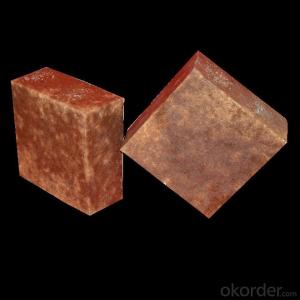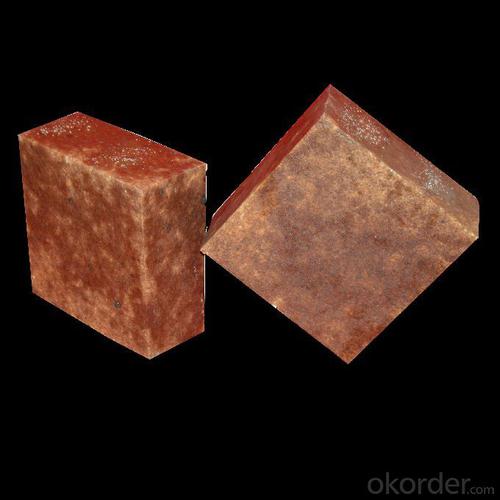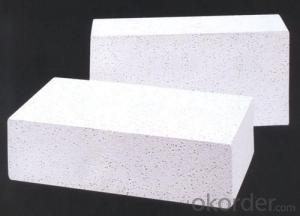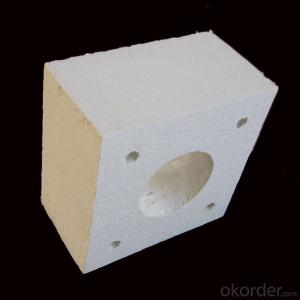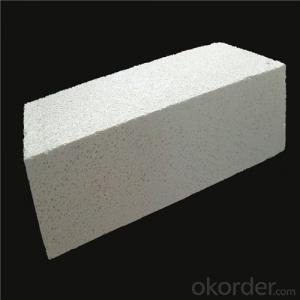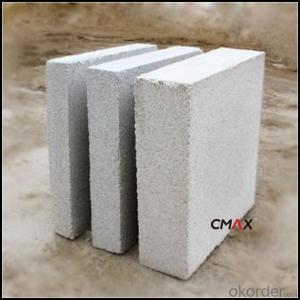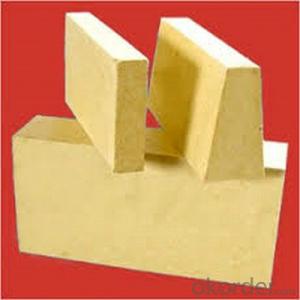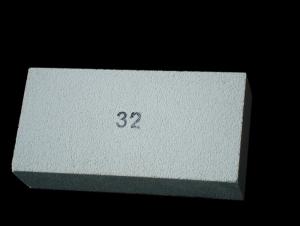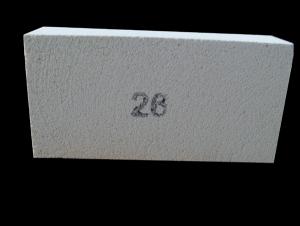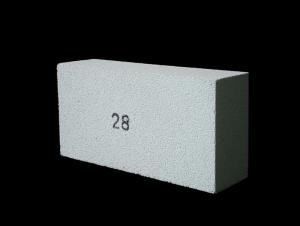Insulating Fire Brick for Ladle High Temperature Refractory Brick
- Loading Port:
- Shanghai
- Payment Terms:
- TT OR LC
- Min Order Qty:
- 10 m.t.
- Supply Capability:
- 100 m.t./month
OKorder Service Pledge
OKorder Financial Service
You Might Also Like
Quick Details
| Place of Origin: | (Mainland) | Shape: | Brick | Material: | Alumina Block |
| SiO2 Content (%): | 60-20% | Al2O3 Content (%): | 40-80% | MgO Content (%): | 0 |
| CaO Content (%): | 0 | Refractoriness (Degree): | 1770°< Refractoriness< 2000° | CrO Content (%): | 0 |
| SiC Content (%): | 0 | Model Number: | 69022000 | Brand Name: |
Packaging & Delivery
| Packaging Detail: | wooden pallet |
| Delivery Detail: | 30days |
Specifications
Refractory bricks for ladle, hot blast furnace
High alumina bricks
Fireclay bricks
Insulating bricks
Runner bricks
Our company located in yangquan city,Shanxi province, China, and Yanquan city is one of the
largest refractory material base in China. We are in position to supply various kinds of
refractory bricks, such as high alumina and fireclay bricks, insulating bricks etc
with the catalogue as follows:
1. fireclay brick
2. high alumina brick
3. insulating brick
4. unsintered phosphate brick
5. Al-C sliding plate
6. nozzle
7. hollowwares
8. refractory Mortar
9. refractory castables
10.other refractory material
If interested, pls do feel free to contact me.
Production can be arranged according to your specific requirements & drawings.
Looking forward to hearing from you the soonest.
FIRECLAY BRICK FOR GENERAL USE
Y-FB GFB40 GFB42 GFB45 |
Al2O3(%)min. 40 40 42 45 |
Fe2O3(%)max. 2.5 |
Refractoriness()min. 1710 1730 1750 1750 |
Refractoriness under load 0.2MPa()min. 1300 1350 1400 1400 |
Apparent porosity(%)max. 22 20 20 20 |
Cold crushing strength (MPa)min. 30 30 35 40 |
Linear change after reheating(%)max. At 1350×2h +0.1 -0.4 At 1400×3h +0.1 +0.1 +0.2 -0.5 -0.4 -0.2 |
Refractory Bricks
item | SK-32 | SK-34 | SK-36 | SK-37 | SK-38 |
Al2O3(%) | 38 | 42 | 50 | 65 | 70 |
Fe2O3 (%) | 3 | 2.5 | 2.5 | 2.4 | 2 |
Refractoriness (SK) | 32 (1710°C) | 34 (1750°C) | 36 (1790°C) | 37 (1825°C) | 38 (1850°C) |
Refractoriness under load, 0.2MPa, Ta, (°C) | 1300 | 1350 | 1450 | 1550 | 1580 |
Porosity (%) | 26 | 25 | 24 | 23 | 23 |
Bulk density (g/cm³) | 2.05 | 2.1-2.15 | 2.3-2.4 | 2.4 | 2.5 |
Cold crushing strength (MPa) | 25 | 25 | 45 | 45 | 51 |
- Q: Refractory bricks, burner bricks, insulation bricks? Is it a kind of thing?
- Not the same thing, refractory bricks and insulation bricks of raw materials, the proportion is not the same. This is the chain of various types of products
- Q: Can insulating fire bricks be used in the construction of fireplaces?
- Yes, insulating fire bricks can be used in the construction of fireplaces. Insulating fire bricks are designed to withstand high temperatures, making them an ideal choice for lining the interior of a fireplace. They have excellent thermal insulation properties, helping to retain heat within the fireplace and prevent excessive heat transfer to the surrounding structure. This not only improves the efficiency of the fireplace but also reduces the risk of damage to the surrounding walls. Insulating fire bricks are lightweight and easy to handle, making them convenient for construction purposes. Additionally, they are resistant to thermal shock, meaning they can withstand rapid temperature changes without cracking or breaking. Overall, insulating fire bricks are a reliable and effective choice for constructing fireplaces.
- Q: Can insulating fire bricks be used in the construction of flue liners?
- Yes, insulating fire bricks can be used in the construction of flue liners. These bricks are designed to withstand high temperatures and provide excellent insulation. They help to retain the heat within the flue, improve the efficiency of the heating system, and reduce the risk of heat transfer to surrounding structures.
- Q: How do insulating fire bricks help improve the efficiency of heating systems?
- Insulating fire bricks help improve the efficiency of heating systems by reducing heat loss. These bricks are designed to have low thermal conductivity, which means they can effectively trap and retain heat within the heating system. By minimizing heat loss, insulating fire bricks help the heating system operate more efficiently, requiring less energy to maintain the desired temperature.
- Q: Several kinds of energy-saving bricks
- Energy saving thermal insulation brick is a new type of energy-saving building insulation technology with inorganic composite materials as the main material. It is an ideal technology to replace the traditional wall insulation.
- Q: Can insulating fire bricks be used for insulation in heat exchangers?
- Insulation in heat exchangers can be achieved by utilizing insulating fire bricks. These bricks are constructed from a lightweight refractory material that boasts exceptional thermal insulation properties. With their low thermal conductivity, insulating fire bricks effectively minimize heat transfer between the two sides of the heat exchanger. Consequently, they aid in maintaining the desired temperature within the heat exchanger and prevent heat loss to the surroundings. Furthermore, the durability of these bricks is evident as they can endure high temperatures and thermal shocks, making them ideal for the harsh conditions typically encountered in heat exchangers. In summary, incorporating insulating fire bricks into heat exchangers not only enhances energy efficiency and reduces heat loss but also improves the overall system performance.
- Q: Can insulating fire bricks be used in the construction of thermal insulation floors?
- Yes, insulating fire bricks can be used in the construction of thermal insulation floors. Insulating fire bricks are specially designed to have low thermal conductivity, which means they can effectively prevent the transfer of heat. This makes them an excellent choice for thermal insulation applications, including floors. By using insulating fire bricks in the construction of thermal insulation floors, the heat loss from the floor can be significantly reduced, leading to improved energy efficiency and cost savings. Additionally, insulating fire bricks are lightweight and easy to install, making them a practical choice for construction projects. Overall, insulating fire bricks are a suitable and effective option for incorporating thermal insulation into floors.
- Q: Are insulating fire bricks suitable for use in residential fireplaces?
- Yes, insulating fire bricks are suitable for use in residential fireplaces. They are designed to withstand high temperatures and provide insulation, making them an ideal choice for ensuring the safety and efficiency of a residential fireplace.
- Q: Do insulating fire bricks have a high thermal conductivity?
- No, insulating fire bricks have a low thermal conductivity.
- Q: What is the typical lifespan of insulating fire bricks in high-temperature applications?
- The typical lifespan of insulating fire bricks in high-temperature applications can vary depending on various factors such as the temperature reached, the specific type and quality of the brick, and the conditions under which it is used. However, on average, insulating fire bricks can last anywhere from several years to several decades in high-temperature applications.
Send your message to us
Insulating Fire Brick for Ladle High Temperature Refractory Brick
- Loading Port:
- Shanghai
- Payment Terms:
- TT OR LC
- Min Order Qty:
- 10 m.t.
- Supply Capability:
- 100 m.t./month
OKorder Service Pledge
OKorder Financial Service
Similar products
Hot products
Hot Searches
Related keywords
